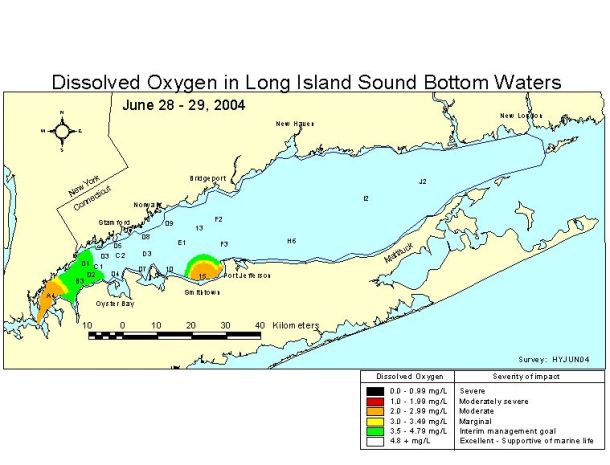Water quality in the western Sound is unusually good to start the summer: Dissolved oxygen readings were above 5 milligrams per liter throughout the Sound in late June. What it signifies for later in the summer, when conditions are usually at their worst, is unknown however.
Healthy levels of dissolved oxygen are essential to the Long Island Sound ecosystem, and typically measurements taken in the waters between Westchester, Fairfield, and Nassau counties in the second half of June show that dissolved oxygen has already dropped below 5, a sign that it is on its way to falling to dangerously low levels for fish and other marine life.
But not this year. You can see it in this unusual all-blue map, produced last week by the Connecticut Department of Energy and Environmental Protection, which conducts water quality testing on the Sound throughout the year. All-blue means that all areas of the Sound have oxygen levels higher than 5.
 Compare that with the map below, from 10 year ago. It shows that dissolved oxygen had already fallen below 3.5 in the far western end of the Sound and in Smithtown Bay.
Compare that with the map below, from 10 year ago. It shows that dissolved oxygen had already fallen below 3.5 in the far western end of the Sound and in Smithtown Bay.

Low dissolved oxygen, known as hypoxia, is the most critical ecological problem facing the Sound. A warm-weather occurrence, hypoxia renders large parts of the Sound uninhabitable for marine creatures. In fact, the immediate effects of hypoxia have been carefully documented over the decades by researchers at the Connecticut DEEP.
They have learned that when dissolved oxygen falls below 4 mg/l, there is a 4 percent reduction in fish biomass in that part of the Sound (fish biomass is the total weight of all the fish caught during standardized research trawls).
When it falls below 3 mg/l, there’s a 41 percent reduction in fish biomass. Below 2 results in an 82 percent reduction, and when dissolved oxygen falls below 1, the reduction is 100 percent — virtually no fish remain.
Hypoxia can be at its most severe anytime from late July through August. Because the Sound is large, deep, and complex, it is impossible to say why conditions in any particular period are as good (or as bad) as they are, and it is impossible to predict what conditions now might mean for the next couple of months.
But it’s worth noting that hypoxia is a warm-water condition, and Long Island Sound was cooler than average throughout the first half of 2014. (Remember that 2012, when the Sound was warmer than average, was one of the worst years for hypoxia.) And as we noted in our report card, the sewage treatment plants along the Sound have done a good to excellent job in meeting federal deadlines to upgrade their treatment processes.
Hypoxia is caused by nitrogen, most of which reaches the Sound in treated sewage. Nitrogen is a fertilizer; it spurs the Sound’s algae to grow in unnaturally large amounts. When the algae die, the decomposition process removes oxygen from the water, resulting in hypoxia.
Treatment plants on the Sound are required to remove 58.5 percent of the nitrogen in their wastewater by 2014-2017.
In addition to watchdogging treatment plants to make sure they meet their goal and then stay there, there are other ways to reduce hypoxia in the Sound and help keep it safe for wildlife. You can take our Long Island Sound Pledge, which is full of actions to help the Sound. And some plants and animals, like mussels and seaweed, act as natural filters to remove nitrogen.
Over the long run, scientists and officials are confident that the reduced amount of nitrogen will solve or dramatically decrease the hypoxia problem. But whether the cool temperatures and lower amounts of nitrogen result in better conditions for the Sound during the critical weeks in late July and August 2014 remains to be seen.
